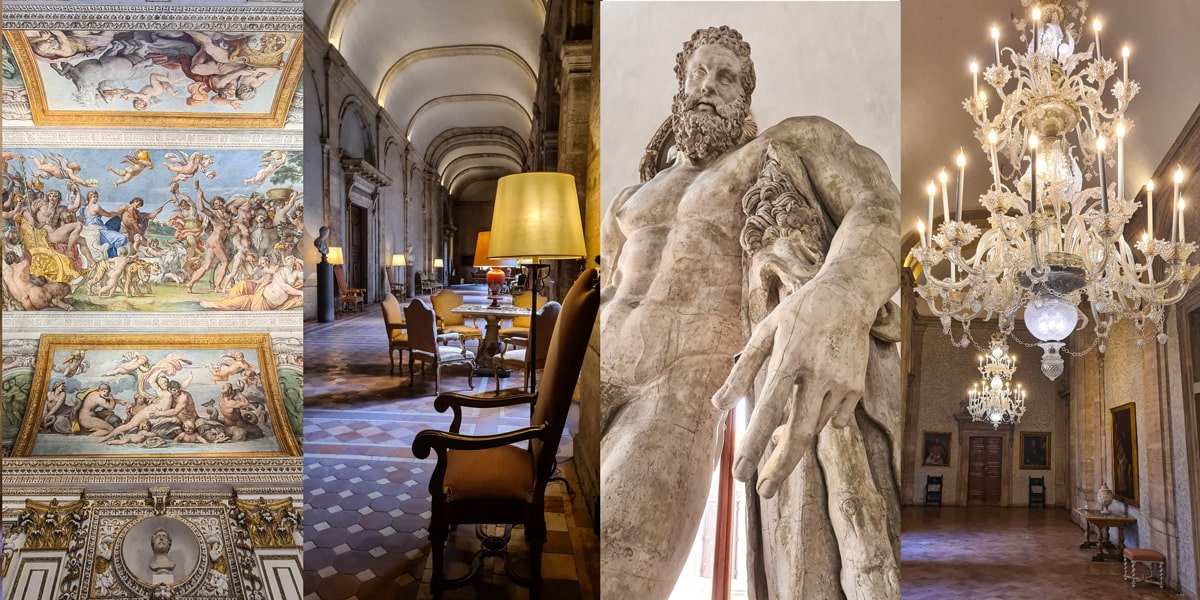

989429 travellers read

| Tickets |
Buy tickets online: |
|---|---|
| Opening hours |
Monday:
-
Wednesday:
-
Friday:
-
|
| Address | Piazza Farnese, 67, 00186, Rome |
| Website | visite-palazzofarnese.it |
Palazzo Farnese in Rome is one of the finest examples of Renaissance architecture in the Eternal City.
Situated in the heart of Rome, this grand palace serves as the French Embassy and boasts a rich history, magnificent frescoes and an impressive art collection. While access to the palace is limited, visitors can join guided tours to admire its breathtaking interiors, including the renowned Carracci Gallery. In this article, we’ll guide you through everything you need to know about visiting Palazzo Farnese, from booking a tour to what to expect inside.
Contents
TogglePalazzo Farnese is one of Rome’s most remarkable Renaissance palaces, commissioned in 1517 by Cardinal Alessandro Farnese, who later became Pope Paul III. Designed by Antonio da Sangallo the Younger, the palace was intended to reflect the wealth and influence of the powerful Farnese family. After Sangallo’s death, the construction was continued by Michelangelo, who added the iconic central window and redesigned the upper part of the façade, enhancing the building’s grandeur. Later, Giacomo della Porta and Vignola contributed to completing the project, making Palazzo Farnese a masterpiece of Renaissance architecture.
During the 16th and 17th centuries, the palace became a centre of political and artistic activity, hosting some of the most influential figures of the time. One of its most famous interior decorations is the Carracci Gallery, a magnificent frescoed ceiling painted by Annibale Carracci and his workshop between 1597 and 1608. The frescoes depict scenes of mythological love, inspired by Ovid’s Metamorphoses, and are considered one of the most outstanding achievements of Baroque painting. Other rooms in the palace were adorned by leading artists of the period, including Francesco Salviati and Daniele da Volterra.
In 1635, the palace became the property of the Bourbon kings of Naples, who enriched its art collections and used it as an official residence in Rome. Following Italian unification in the 19th century, Palazzo Farnese was leased to France, and in 1936 it officially became the seat of the French Embassy in Italy. Today, while it remains a diplomatic institution, the palace occasionally opens its doors to visitors through guided tours, offering a rare glimpse into its artistic treasures and centuries of history.
Visiting Palazzo Farnese is a unique experience, but it requires some planning as the palace is not open for general public access. As someone who has visited, I can share the exact steps to help you secure a place and know what to expect on the day of your visit.
First, you need to book a guided tour through the official website of the French Embassy in Italy, as it manages access to the palace. Tours are available in multiple languages, including Italian, French and English, but they are infrequent, so it’s best to reserve well in advance.
Once you’ve booked, you will receive a confirmation email with details about your visit. It is essential to arrive at least 15–20 minutes before your scheduled tour, as security checks are strict. Since Palazzo Farnese houses the French Embassy, you must bring a valid passport or ID, which will be checked at the entrance. Security staff may also inspect your bags; large backpacks or luggage are not allowed inside.
Tours usually last about 90 minutes and are led by knowledgeable guides who explain the palace’s history, architecture and artwork. Photography is generally not allowed inside, so be prepared to enjoy the beauty of the palace without taking pictures.
If you need to cancel your visit, check the embassy’s cancellation policy in advance. Some tours allow for changes, but last-minute cancellations might not be refundable. As places are limited, it’s a good idea to finalise your plans before booking to avoid missing out.
Overall, visiting Palazzo Farnese is a fascinating experience, offering a rare glimpse into one of Rome’s most prestigious Renaissance palaces. If you’re interested in history, architecture or art, I highly recommend making an effort to secure a tour—you won’t be disappointed!
I also recommend an article about the Regola district in Rome.
Visiting Palazzo Farnese was an exceptional experience, and I highly recommend it to anyone who loves history, art and hidden gems in Rome. The palace’s stunning Renaissance architecture, the breathtaking frescoes of the Carracci Gallery, and the fascinating stories behind its construction make it one of the most impressive historic residences in the city. While access is limited and requires booking, the effort is worth it.
Walking through its grand halls and admiring the masterpieces up close felt like stepping back into an era of power and artistic brilliance. The knowledgeable guides provided incredible insights, making the visit even more engaging. If you’re looking for something beyond the usual tourist attractions in Rome, Palazzo Farnese is a must-see. Just be sure to plan, bring your ID and enjoy the rare opportunity to explore one of the most beautiful palaces in Italy.
Author: Kate Zusmann
This website uses cookies. For more info read the cookies policy
RomeItaly.guide © 2025. Created with love by Roman experts and guides.